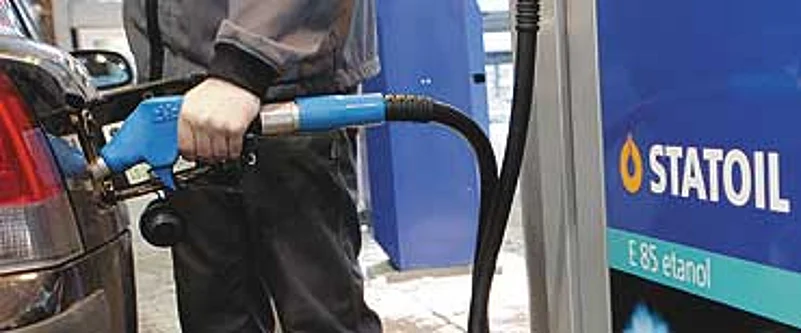If ever a good Hindu should want to take the train between Linkoping and Vastervik in Sweden, it might be best not to think it runs on dead cows—at four kilometres per cow to beprecise. The entrails are processed for a month to produce the methane the train, Amanda, runs on. But call it biomass fuel, and Amanda will not appear such a sinner any more; just a train making rapid progress along a revolutionary track.
But the travelling Hindu is likely to be far more comfortable on a bus in Brazil. The ethanol it’s likely to run on is made, after all, from wheat, beetroot, corn or sugarcane—a nice vegetarian ride. It just might be okay in Germany too where a taxi takes a good deal of biodiesel made from all sorts of mix of rapeseed, sunflower and soy oil, though often with some animal fat thrown in.
But of course, look at what all this is not; it’s not mineral oil from Saudi Arabia, Russia or Venezuela. Not many are worrying yet about that oil running out, but everybody is worried about its price rising higher and higher. The price of oil has tripled since 1996. In another 10 years, maybe 15 or 20, you could be entering doomsday scenario.
It’s the year 2020. Not one oil tanker sails in from the Gulf or Russia, not a barrel of the stuff rolls off another, not at a price you can pay anyway. That doomsday could come true for India, it may not for Sweden or Brazil. Sweden hasn’t found oil; it’s just growing it. Like Brazil has, and like India is just about beginning to.
What Sweden and Brazil have brought in is nothing less than a revolution of the renewable. By 2020, says Swedish minister for sustainable development Mona Sahlin, no Swedish home will need oil for heating. "No motorist will be obliged to use petrol as the sole option available. By then, there will always be better alternatives to oil." Sweden has sounded the oil alarm.
Already, one in seven Swedish cars runs on biofuel. The cars come cheaper with tax discounts, they are spared congestion charges, and some municipalities offer them free parking. An Electricity Certificates Act passed in May 2003 provides for green certificates to favour electricity production from renewable sources like biomass and wind. Two-thirds of district heating now comes from biomass. A Commission on Oil Independence headed by the prime minister is constantly looking for new ways to wean Sweden away from mineral oil dependence. And it is finding ways, in the meanwhile, to save energy, such as getting Swedes to spend less time in the shower. And so far no one is complaining of a Swedish smell.
"The Swedes have been real smart," Jeffrey McNeely, chief scientist withIUCN—the World Conservation Union, a leading environment group, told Outlook. More than oil price rise, Sweden and Brazil are insulating themselves against security shocks. "You can imagine some different scenarios about how things might play," McNeely said. "To me, the very worst would be an attack on Iran’s nuclear facilities. Beyond the ethics of it—and to me that is already enough—Iran would stop exporting oil. And that would drive the oil price to $120, maybe $150 a barrel, and then what happens to poor people?"
Sahlin was engaged in extensive talks in Washington this week on the security implications of an energy crunch. "Many international conflicts today revolve around energy issues," she told a conference on Beyond Peak Oil. "Being able to rely on domestic and sustainable energy would also be beneficial in terms of security policy."
For Sweden and Brazil, sustainable does not mean nuclear, the new partnership that India is developing so controversially with the United States. "Neither uranium nor oil are inexhaustible resources," Sahlin said. Like oil, uranium deposits could also run out in about 20 to 30 years, says Stephane Lhomme from the Paris-based anti-nuclear group Sortir dunucleaire (get rid of nuclear power). India could just end up with staggeringly expensive nuclear plants one day—with not enough uranium for them.
On present policy, India is lurching from oil to nuclear dependency, with only some recent and still weak moves towardsbioenergy. Of course, the energy needs of Sweden’s population of nine million are a lot less than India’s. And there could be some limits also to following the Brazilian model because Brazil has a far better people-to-land ratio than India— a population of 188 million for a country three times the size of India.

That could make it a little harder for India to grow energy crops rather than food crops, despite a new rush to plant energy crops, particularly jatropha. What the ongc could not give oil diggers through its offerings of onshore and offshore exploration blocks, the weedy jatropha might. Its seeds can be crushed to produce oil you could run a truck on. But jatropha and its oily botanical cousins could take only that many cars and trucks that far.
"With biofuels, you have a trade-off between land you can use to produce fuel and land you can use to produce food," McNeely said. The poisonous jatropha promises to grow on arid land, and that is promise enough to get some oil giants interested. British BP announced in February this year that it will fund a $9.4 million jatropha cultivation project by The Energy and Resources Institute(TERI) in Andhra Pradesh. The project, which is expected to take 10 years, will cultivate around 8,000 hectares of land to produce an expected nine million litres of biodiesel a year.
A wave of new Indian entrepreneurs has joined the jatropha rush to produce biodiesel. Good business so far as it cuts dependence on oil import but the yields are expected to be relatively small and over a relatively long period.
The new biodiesel rush follows largely the European model. "Europe produced more than 3.2 million tonnes of biodiesel last year," Anne Nuria Kemnitz from the European Biodiesel Board toldOutlook. That fell short of the target of 2 per cent of all diesel use for the year. The next target is 5.75 per cent for 2010 and then 25 per cent for 2030. About the time mineral oil would certainly be too expensive to burn.

The popular path so far is biodiesel blends. Pure biodiesel use will require some engine redesigning because biodiesel is a little harder on present engines than mineral oil. But it’s a brave new market and the Brazilians are running their fleets fine with gasohol produced from sugarcane and the like. And better oil might just come from crops genetically modified for that purpose. "India may have to look more to biotechnology, though that is not an option particularly popular with environmentalists," McNeely said. Energy crops could simply be modified genetically for high yields in difficult conditions.
"There is no one way of producing biofuel," says Julia Yakimova from BP. "And it is more expensive than importing mineral oil. The cost of production has been going down as the cost of mineral oil has risen, but since the cost is still higher, government incentives will be needed." For the Indian government that might mean subsidies at a level it cannot pay.
The way forward for India may have to be the way backward, says McNeely. "Throughout its history, India has used mainly biofuel. Only in the last century, it has switched to fossil fuel." And that may well point to the need to extract energy from waste. "It may be the better solution to convert waste into fuel," Yakimova said. "Timber waste being turned into fuel may be better than rapeseed oil. But finding ways to convert waste into fuel may take a long time."
Not that long necessarily, particularly for power generation. The Swedes are using the branches of willow trees for power generation. A Rwandan prison is now powering itself through processing human waste into energy. Delhi might just have the potential to power itself enough on its own waste to cut out power cuts, and clean up the Jamuna in the bargain. Delhi’s decision-makers, like everyone else in the city, might just be sitting on the solution.
The new energy that faraway Sweden and Brazil are finding can partially be duplicated in India. "But India is such a vast country and different things will work in different parts," McNeely said. Entrepreneurs and innovators have found all sorts of solutions but India has no policies in place yet that could significantly reduce that dependence on Saudi or Russian oil. "India has tremendous technological resources that it must mobilise on a very urgent basis to look at alternatives," McNeely said. "You cannot wait until a need develops. I’m sure Manmohan Singh understands the urgency of the problem. It is incredibly urgent to get started."
by Sanjay Suri in London


























